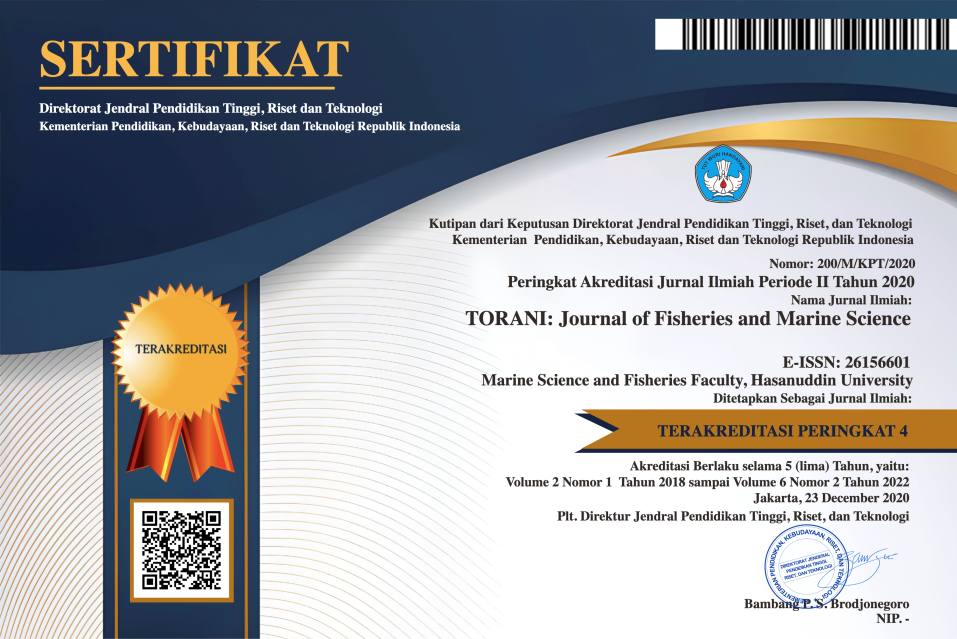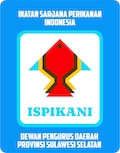TRANSFORMASI GELOMBANG DI PANTAI SUKAMARA PROVINSI KALIMANTAN TENGAH
DOI:
https://doi.org/10.35911/torani.v26i1.2616Abstract
Refraction pattern of waves on the coast Sukamara have been known to conduct research in the year March –April 2014 . The prediction results showed that each season surge wave parameters that form there is adifference. This is because of differences in factors affecting pembangkitkan waves such as wind speed, duration,wind direction, and fetch. I transitional seasons wave direction most of the south and southeast (26.09 %) withheight and wave period at intervals ranging from 2.2 m - 3.1 m and 7.7 s - 8.7 s, the biggest wave of thesouthwest (3.8 m and 9.3 s). East monsoon waves are formed predominantly from the southeast (55.56 %),height and wave period at intervals ranging from 1.7 m - 2.7 m and 6.9 s - 8.1 s. The wave season is from thesouth east which is a storm surge of 3.5 m and 9.0 s. In the second transition back waves varies with thedirection of most of the southeast (26.92%) with height and wave period range in the interval from 1.9 to 3.1 mand 7.2 s - 8,5s. Due to refraction and shoaling pattern, so that the wave will experience changes in height,velocity and wavelength smaller than in the ocean waves. Deflection direction that causes the wave height of thewave decreases due to the speed and wavelength decreases. Convergence (penguncupan waves) generallyoccurs on the contour/coast which juts out (headland) and sund dune area, whereas divergence (spread waves)occur in the contour/coast that juts into the (bay area). Areas experiencing convergence generally cause abreaking wave height greater than the divergence area.Keywords: Sukamara coast, wind direction, wind speed, refraction, konvergen and divergenDownloads
References
[CERC] Coastal Engineering Research Center 1984. Shore Protection Manual Volume I, Fourth Edition.
Washington: U.S. Army Coastal Engineering Research Center.
[CHL] Coastal Hydraulic Laboratory 2006. Coastal Engineering Manual, Part I-VI. Washington DC:
Department of the Army. U.S. Army Corp of Engineers.
Dewi, I.P, M. Purba and I.W. Nurjaya, 2011. Perubahan Garis Pantai dari Pantai Teritip Balikpapan
sampai Pantai Ambarawang Kutai Kartanegara Kalimantan Timur. Tesis Program Pasca Sarjana.
IPB. Bogor
[Dishidros] Dinas Hidro Oeanografi 2007. Daftar Pasang Surut Perairan Indonesia. Jakarta: Jawatan Hidro –
Oseanografi Angkatan Laut.
Ongkosongo OSR, dan Suyarso 1989. Pasang Surut. Jakarta: Lembaga Ilmu Pengetahuan Indonesia (LIPI),
Pusat Pengembangan Oseanologi.
Pariwono, J.I. (1989). Pasang Surut. Lembaga Ilmu Pengetahuan Indonesia (LIPI)-Pusat Penelitian dan
Pengembangan Oseanologi, Jakarta.
Sakka, M. Purba and I.W. Nurjaya, H. Pawitan, V.P. Siregar, 2012. Transformasi Gelombang di Sepanjang
Pantai Delta Sungai Jeneberang, Makassar. Torani Jurnal Ilmu Kelautan dan Perikanan, Vol. 22 No.
, Hal. 36-48.
Siegle E, Asp NE. 2007. Wave Refraction and Longshore Transport Patterns Along The Southern Santa
Catarina Coast. Brazilian J Oceanograp 55(2):109-120.
Triatmodjo B. 1999. Teknik Pantai. Yogyakarta: Beta Offset.
Triwahyuni A, M. Purba, S.B. Agus. 2010. Pemodelan Garis Pantai Timur Tarakan, Kalimantan Timur.
Ilmu Kelautan: Indo J Mar Sci 1(Edisi Khusus):9-23.



















